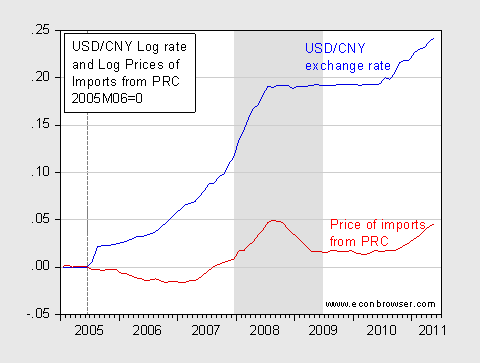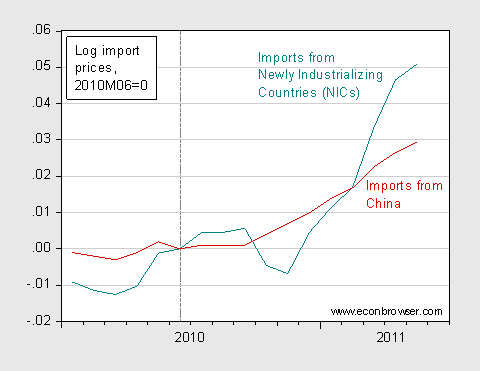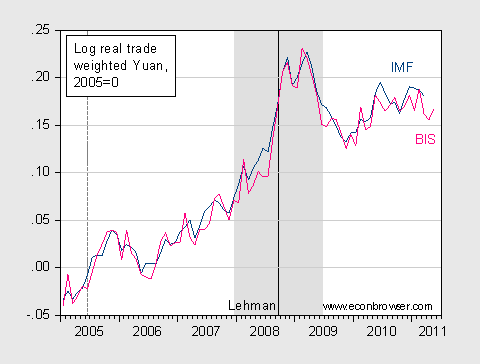Or more on China-U.S. exchange rate pass through
Tuesday’s Wall Street Journal illustrated the conflicted nature of American views regarding real yuan appreciation. The front page article by Hilsenrath, Burkitt and Holmes argued “Change in China Hits U.S. Purse”. On the back page of the C section was a countering article, “No appreciation for the rising yuan”, by Orlik, that noted the moderate impact on prices of imported goods from China.
The front page article stressed the fact that as the yuan appreciates, and Chinese labor costs rise, then the price of imported goods that constitute a large part of the bundle of goods purchased by lower income households also rise, thus pushing up the overall cost of living.
That epoch [of cheap imported goods from China] appears to be over. Prices of imported goods are climbing becoming a source of inflationary pressure. A wide areity of common products made abroad… are landing on U.S. docks with higher price tags.
From the back-page article:
A rising yuan has actually done little to force of the price of China’s exports. Data collected by the U.S. Bureau of Labor Statistics show the price of U.S. imports from China in May up just 2.8% year on year. That is higher than in past years, but it still means only a fraction of the yuan’s gains are so far being passed through into higher prices.
Can both articles be right (or both wrong) at the same time?
Interpreting the Statistics in the Context of the Literature
Neither of the articles graphically illustrate the relationship between exchange rates and import prices implicitly described in the text. Hence, I provide Figure 1.

Figure 1: Log USD/CNY nominal exchange rate (blue), and price of goods imports into the US from the PRC (red), both normalized to 2010M06=0, 2010M01-2011M05 period. Source: St. Louis Fed FREDII, BLS, and author’s calculations.
The issue at hand is exchange rate pass-through, which I discussed here and here. It is useful to recall the identity, in logs:
p$Import = s$/¥ + p¥Export
Where p$Import is the log dollar price of imported goods from China, s$/¥ is the log exchange rate, in number of USD per CNY, and p¥Export is the log CNY price of Chinese exports to the US. Taking the first difference:
Δp$Import = Δs$/¥ + Δ p¥Export
A percentage point change in the exchange rate should, ceteris paribus, induce a percentage point change in the dollar import price. Of course, not all else is held constant, and the yuan price might change. In other words, Chinese exporters might choose to absorb a part of a yuan appreciation in profit margins.
In this post on Chinese export pass through in to US imports, I cited a study by Cui et al. (2009), that identified an exchange rate pass through coefficient of around 0.5, consistent with my own estimates of around 0.52 over the 2005M07-2010M12 period for imports into the U.S. Viewed in this light, the behavior of prices of imported Chinese goods over the last year has been fairly in line with expectations.
I am always wary of examining relationships over too short a period; hence Figure 2 presents the same series over the 2005M01-2011M05 period.

Figure 2: Log USD/CNY nominal exchange rate (blue), and price of goods imports into the US from the PRC (red), both normalized to 2005M06=0, 2005M01-2011M05 period. NBER defined recession dates shaded gray. Source: St. Louis Fed FREDII, BLS, NBER, and author’s calculations.
Figure 2 appears to indicate that exchange rate pass through was lower during the longer period. However, the price is also determined by costs, and over part of the sample period (2003-05 in particular), unit labor costs were probably dropping due to rapid productivity growth, as discussed in this post.
What is true is that, in line with my arguments at the IMF forum on a new development model for China at the Fall 2010 Bank-Fund meetings, resumption of CNY appreciation has given cover for other East Asian countries to allow their currencies to appreciate (as pointed out in the Orlik article). Import prices from the Newly Industrializing Countries (NICs) have as a consequence also risen.

Figure 3: Log import prices from Newly Industrializing Countries (NICs) (teal), and from the PRC (red), both normalized to 2010M06=0, 2010M01-2011M05 period. Source: BLS and author’s calculations.
The Impact on Overall Price Level versus Relative Price Changes
As I have noted before [1], I have found the argument that higher Chinese export prices would translate into higher US inflation a bit overwrought — not because it is a qualitatively incorrect implication, but rather because on quantitative grounds, non-oil import prices do not appear to be important determinant of overall inflation in industrial countries.
For instance, as noted here, the pass through of aggregate import prices into US consumer prices has appeared to be declining over time. From Mishkin’s 2008 survey of exchange rate pass through and monetary policy:
The correlation between consumer price inflation and the rate of nominal exchange rate depreciation can indeed be high in an unstable monetary environment in which nominal shocks fuel both high inflation and exchange rate depreciation. But a salient feature of the data is that this correlation has been very low over the past two decades for a broad group of countries that have pursued stable and predictable monetary policies. Moreover, the evidence suggests that even countries in which inflation and exchange rate depreciation appear to have been fairly closely linked historically have experienced a sizeable decline in pass-through following the adoption of improved monetary policies.
And, from a more recent DeutscheBank analysis (Hooper, Mayer, Spencer, Slok, “Exchange rate and commodity
price pass-through in Asia,” Global Economic Perspectives, New York: DeutscheBank, June 17, 2011, not online):
We employ a recursive VAR approach to modeling Asian inflation in
which we include international oil, food and core consumer prices, the
exchange rate, domestic money supply and output as determinants of
inflation.We find very weak pass-through of exchange rate changes to consumer
prices. This suggests that exchange rate appreciation itself is unlikely to
significantly reduce inflation. In fact, only in India, the Philippines, South
Korea, Thailand and the US would we consider the exchange rate passthrough
effect to be significant and even there it is generally small and
short-lived.
These assessments are at variance with the perspective of a significant and pervasive impact from China [2], although persistent Yuan undervaluation might have a different effect than discrete changes in exchange rates.
So, as I have pointed out before, faster CNY appreciation will lead to a change in the relative price of Chinese and other imported goods, rather than inducing a price level increase, facilitating the switch of US production toward tradables. This is key to rebalancing the US economy. The empirical evidence (i.e., econometric studies) suggest that higher import prices do not manifest themselves into substantially higher general prices, so inflation is not the primary concern here. That does not deny that certain households will be impacted more than others by those relative price changes.
The Enduring Mystery of Slow CNY Appreciation
That being said, Orlik’s article does highlight certain important points:
The brutal truth for U.S. manufacturers is that improvements in productivity in Chinese firms, and willingness to accept lower margins, are counterbalancing the impact of a rising yuan on their competitiveness.
As important, the yuan’s gains against the dollar have not been enough to compensate for the dollar’s fall against most other currencies. The yuan has actually fallen 3.7% on a trade weighted basis in the last year, and is down 8.4% against the euro. That is especially bad news for the manufacturing sectors of crisis-afflicted Greece, Spain and Portugal. Those who find themselves competing with Chinese manufacturers will find life even tougher.The outlook for appreciation is little better. High inflation might encourage Beijing to let the yuan rise slightly faster. But the weight of the argument is shifting in the other direction. Concerns about growth will strengthen the export lobby’s argument for exchange rate stability.
Perspective is important. While it is true that the trade weighted nominal yuan had depreciated over the last year, the real yuan has barely budged; and over a longer horizon, the yuan has trended upward in real value against other currencies.

Figure 4: Log real trade weighted yuan from IMF (dark blue), and from BIS (pink), both normalized to 2005M01, 2005M01-2011M05 period. NBER defined recession dates shaded gray. Source: St. Louis Fed FREDII, BLS, NBER, and author’s calculations.
That being said, CNY appreciation should be faster, even from the Chinese perspective. Eswar Prasad, who was head of the IMF’s China desk for two years, shares my puzzlement in his recent testimony to the U.S.-China Economic and Security Review Commission:
A currency appreciation would serve the dual objectives of tamping down inflationary
pressures and helping to shift the balance of growth towards private consumption.
Indeed, a more flexible currency would eventually allow the central bank a much freer
hand in changing interest rates to meet the twin objectives of high growth and low
inflation. A currency appreciation would help rebalance growth by increasing the
purchasing power of domestic households. This would happen directly through the fall
in the price of imported goods and also by giving the central bank room to raise deposit
rates, giving households a better rate of return on their savings.
All of this makes it surprising that China has not used currency appreciation more
aggressively as a tool in the fight against inflation and as one way of promoting more
balanced growth. It seems that a huge political bar has to be crossed before the
Chinese leadership accepts the use of currency policy as a tool against inflation. The
twelfth five-year plan has little to say on this subject other than the ritual affirmation of
steps to improve the exchange rate formation mechanism.
One can only hope that Chinese policymakers see the wisdom in faster CNY appreciation, and soon, as inflationary pressures in China remain unabated (although, Lardy sees slowing inflation in 11Q3).
In the Hilsenrath, Holmes, Burkitt article there’s an anecdote about a shopper. She pays much higher prices for products produced in China than exporters actually get. What happens when chinese pay the same prices for their goods as foreigners?
Really nice post. Reminds me how much I miss Brad Setser’s blog.
Faster CNY appreciation would be associated with higher Chinese interest rates & higher export prices, both of which will expose the house of cards that is the structure of production in China. It will expose the unprofitability of vast amounts of investment in China, to wit, vast amounts of misdirected/wasted resources.
A little higher inflation will force their hand, forcing them to entirely cease buying US & Euro debt with fresh RMB & bring on a Chinese collapse.
HK$ supplies enough evidences of the existence of domestic stability bumpers within external monetary,and exchange rates turbulences.
The bumpers being the real estates prices absorbing imported money supply.China can afford assets prices increases along the same process.
As long as the outside world real interest environment will remain low,it may be difficult to see a reduction of the current account deficit among China partners countries.
The foreign exchange rates may not be the suitable policy.
Bryce A little higher inflation will force their hand, forcing them to entirely cease buying US & Euro debt with fresh RMB & bring on a Chinese collapse.
Sounds like your inner Austrian is showing through. Can’t have enough liquidation in this world, now can we. Gotta purge the sysem of all those “vast amounts of misdirected/wasted resources.”
lol Slug. Liquidation is a codeword for destroying the middle classes savings and giving it all to the rentier.
Great post – thanks. What do you think the chances are that China will be forced to allow quicker RMB appreciation in order to fight inflation?
2slugbaits, I’ll let reality argue this one for me. It will not be long now.
Menzie posed in so many words the question of why the Chinese don’t appreciate CNY. I provide the answer. You mock it without explaining why it is wrong.
Does the US FED ever listen to the IMF? Note the slight change in bold.
A dollar appreciation would serve the dual objectives of tamping down inflationary pressures and helping to shift the balance of growth towards private consumption. Indeed, a more stable currency would eventually allow the central bank a much freer hand in allowing market interest rates to meet the twin objectives of high growth and low inflation. A dollar appreciation would help rebalance growth by increasing the purchasing power of domestic households. This would happen directly through the fall in the price of imported goods and also by giving the central bank room to raise deposit rates, giving households a better rate of return on their savings.
Bryce, it is you who is not seeing reality as why the Chinease won’t appreciate. Has little to do with inflation.
Both articles seem to point to yuan appreciation whichever way is not going to help US ecconomy
I think it was Morris Goldstein who pointed out, like a couple of years ago, that US pressure on China to upvalue the Yuan had no chance of doing anything much for America — that the main effect would be on Vietnam and Indonesia, among others, who would suddenly become much more competitive in supplying Chinese industry with subassemblies and offshored production.
To us over here China looks like a low cost labor exploiter. Within Asia, by contrast, China is a high wage advanced country, and business people in the lesser Tigers are licking their chops waiting to get into that market as bracero producers.
Yuan appreciation is definitely not favored. “China stumbles in Yuan Grand Plan”, which is an article on Wall Street Journal, says that the Chinese are having a lot of problem to do that.